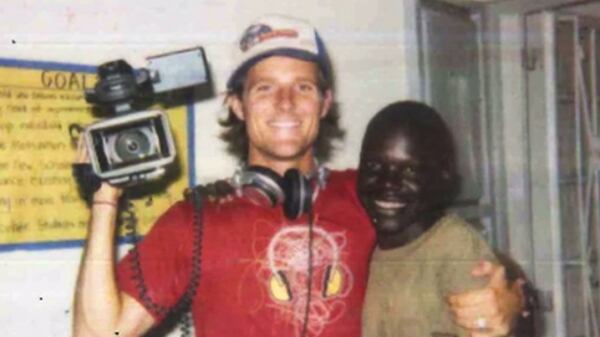Last Friday was a typical weekend night at the Davis Restaurant and Bar in Eugene, Ore., which means a DJ was bumping contemporary hits like “Piss Test” to a throng of inebriated youngsters fogging up the windows as they scanned the dance floor in search of potential make-out buddies.
What was different about last Friday night, explained the ponytailed, fedora-wearing emcee via an occasional interruption of the beats, was that this dance party was for a good cause.
“Sending this back to Uganda, with Invisible Children,” came the voice-over. “Thank y’all for supporting this cause.”
Invisible Children, as tens of millions of people now know who didn’t before, is the San Diego–based charity that put out a video a few weeks back starring cofounder Jason Russell, his cute kid Gavin Danger, and an evil African warlord named Joseph Kony who has been abducting innocent Ugandan children and forcing them to kill people.
It’s a charity that quickly found itself in the same uncomfortable spotlight into which Invisible Children thrust Kony, in the days after its viral video hit YouTube, climbing to 100 million views faster than any ever had; faster than Rebecca Black’s god-awful “Friday,” even. The simplistic focus on a complicated problem across the world left critics from the U.S. to Uganda mocking the campaign to #stopkony.

Kony’s not in Uganda anymore, the naysayers pointed out. Only a third of Invisible Children’s revenue is spent on “direct program services” in that country. And on and on, the backlash reaching such a fever pitch that Russell cracked, had a very public, very naked meltdown, and is now in recovery. At a showing in Uganda, attendees threw rocks at the screen, confused about why the first 10 minutes of a video about Africa had hardly any Africans in it and about why people were being encouraged to wear T-shirts with a hated warlord’s picture on them. Last week, a video of one of the founders drinking from a vodka bottle and bragging about how Invisible Children got a million dollars and kept $900,000 (he later explained he was joking) seemed only to bolster the haters’ hating.
None of this controversy has slowed the San Diego filmmakers down, though. The charity’s current pledge count is 3.5 million. On March 21 a bipartisan group of 33 senators sponsored a resolution condemning Kony’s war crimes, and other lawmakers are talking about gathering up private funding for a bounty. Two days after the Senate resolution was introduced, the African Union announced it was sending 5,000 soldiers to look for Kony.
And by the wee hours of Saturday morning, Eugene substitute teacher Beth Kruziki had raised about $500 in cover charges and cash donations toward her plane ticket and lodging for one of the charity’s on-the-ground programs: a teacher exchange.
Because the Davis almost always charges a cover on weekend nights, Kruziki’s total was as much a donation from its owner, Tom Kamis, as it was from any of the dance party’s attendees. But Kamis was happy to help, and he’s not the least bit discouraged from supporting his longtime friend Kruziki or Invisible Children, blowback notwithstanding.
When Kamis watched that “Kony 2012” video, he was embarrassed that it became such a phenomenon, he said. Embarrassed because that meant his fellow Americans didn’t already know about Joseph Kony’s evil deeds. And when people started to hate on it, Kamis wasn’t surprised. Critics just wanted a reason to justify their own ignorance, he told The Daily Beast. We didn’t know about it because we didn’t need to, because this Kony guy is on the run, because he’s irrelevant, because these San Diego dudes aren’t really legit.
“Anything to make it OK not to have to think about this,” Kamis said.
Kruziki has been plugged into Uganda’s plight since she watched one of Invisible Children’s earlier videos in church seven years ago. She donated money long before “Kony 2012” came out, and she applied to the teacher exchange last year. She’s not some “slacktivist” brainwashed by a slick propaganda film. She was out to #stopkony before it was cool.
“Their hearts are in a good spot,” Kruziki said of Invisible Children, even if the message has been a little muddled of late. “They’re coming from a good place. When you put yourself out there, you’re going to get criticism.”
Invisible Children’s mission of the past few weeks has been to respond to that criticism, with aplomb. CEO Ben Keesey tells The Daily Beast that he and his staff have answered thousands of emails and phone calls this week, have put out more short videos to answer any question anyone has about the charity, and have constantly refined a section of its website devoted to answering “critiques” of the charity.
“I expected the film to stir up questions, for people to get fired up on the issue. I did not expect the story to be turned toward us. It took a toll on us. It was hard to be attacked that way, personally,” Keesey said. “It was a 29-minute film. I felt like people were kind of judging our whole organization by what can you put in 29 minutes.”
The urgent focus now is to shift the focus away from Invisible Children and Jason Russell’s sidewalk banging and back to Africa. And the beauty of it is, the charity’s megaphone for accomplishing this mission is now giganticized.
Before the “Kony 2012” premiere, Invisible Children’s Facebook fan page had 444,461 “likes,” and its Twitter profile had 54,573 followers. A week after the video went viral, there were more than 3 million Facebook fans and 417,000 followers.
The film was simplistic by design, and Keesey knew it would raise some skeptical questions, he told The Daily Beast. The charity was prepared for that, eager to pique people’s curiosity and then satisfy the demand for more specifics. That was the whole point.
“We know this is a heavy subject that confronts people in an emotional way,” Keesey said. “This is not Jersey Shore.”
But what caught Keesey flat-footed, besides the viciousness of the critique and personal attacks against Russell, was how much of a case they’d have to make that Joseph Kony and his Lord’s Resistance Army are really still bad-enough dudes to warrant an international manhunt, a global fundraising effort to hunt down the warlord. Keesey now realizes that the brief references to Kony still being “out there” and that the LRA had moved into other African countries weren’t enough.
“We didn’t necessarily think that the LRA moving into neighboring countries, that that was breaking news. It happened five years ago,” Keesey said. “We didn’t think the point needed to be made multiple times. But it wasn’t clear enough, and it led to a lot of these questions. ‘Are they even a problem anymore?’ We could have said it more times, more explicitly, more than once.”
That’s why Invisible Children is about to release another video this week, so make some room on your Facebook pages. This time, the protagonist won’t be Russell and his cherub-cheeked spawn, but villagers in the remote regions of Africa where the LRA continues to wreak havoc. This time Invisible Children will build a better case.
“The LRA crisis tracker shows that 41 people have been abducted since this movie was released,” Keesey said.
Whether that video will hit 100 million views is anybody’s guess. But an important thing to remember is that part of the reason “Kony 2012” went viral is that Invisible Children has been building a network for eight years: a Twitter following, a Facebook fan page, an email list. That video reached so many new viewers because so many people like Beth Kruziki were already plugged in, ready to distribute the message.
Now the charity’s distribution list is staggering. With the click of a button, 3.2 million Facebook fans and 400,000 Twitter followers will be instantly exposed to whatever Invisible Children wants them to hear. And whether the “Kony 2012” sequel garners cheers or jeers, there’s no such thing as bad publicity.






